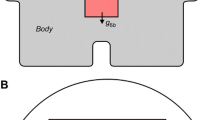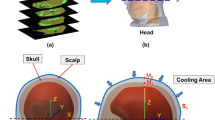Abstract
Therapeutic hypothermia is rapidly becoming an integral part of post-resuscitative care for post-cardiac arrest and neurotrauma patients. Despite the significant impact of thermoregulation on core temperature drop during rapid cooling, current mathematical models for thermoregulation have not been validated for hypothermic conditions. A geometrically accurate 3D model of an upper leg was developed by segmenting anatomical images from the visible human dataset into fat, muscle, bone, and blood vessels. Thermoregulation models from literature were implemented in the model. The numerical model results were compared with surface cooling experiments. There was a good agreement of simulation results with experimental data at 18 °C water immersion using existing models. However, at lower temperatures, the model parameter values needed to be significantly altered to account for cold-induced vasodilation in the superficial blood vessels and variation in muscle perfusion to match experimental observations. Additionally, results indicate that thermal mass has a dominant effect on cooling rate; therefore, uniform cooling over a large surface area will be more effective than targeted cooling of areas with superficial blood vessels. This study is the first to analyze the effects of thermoregulation in hypothermic conditions and identify unique thermoregulatory effects that differentiate hypothermic and normal conditions.






Similar content being viewed by others
References
Ahmad FU, Wang MY, Levi AD (2013) Hypothermia for acute spinal cord injury—a review. World Neurosurg 82:207–214. doi:10.1016/j.wneu.2013.01.008
Bernard SA, Smith K, Cameron P et al (2012) Induction of prehospital therapeutic hypothermia after resuscitation from nonventricular fibrillation cardiac arrest. Crit Care Med 40:747–753. doi:10.1097/CCM.0b013e3182377038
Bogerd N, Psikuta A, Daanen HAM, Rossi RM (2010) How to measure thermal effects of personal cooling systems: human, thermal manikin and human simulator study. Physiol Meas 31:1161–1168. doi:10.1088/0967-3334/31/9/007
Bristow GK, Sessler MD, Giesbrecht GG (1994) Leg temperature and heat content in humans during immersion hypothermia and rewarming. Aviat Sp Environ Med 65:220–226
Cabanac M (1993) Selective brain cooling in humans—fancy or fact. FASEB J 7:1143–1146
Cappuccino A, Bisson LJ, Carpenter B et al (2010) The use of systemic hypothermia for the treatment of an acute cervical spinal cord injury in a professional football player. Spine 35:E57–E62. doi:10.1097/BRS.0b013e3181b9dc28
Dennis BH, Eberhart RC, Dulikravich GS, Radons SW (2003) Finite-element simulation of cooling of realistic 3-D human head and neck. J Biomech Eng 125:832–840
Diao C, Zhu L, Wang H (2003) Cooling and rewarming for brain ischemia or injury: theoretical analysis. Ann Biomed Eng 31:346–353. doi:10.1114/1.1554924
English MJ (2008) Heat transfer coefficient: Medivance Arctic Sun Temperature Management System vs. water immersion. Unpublished raw data
English MJ, Hemmerling TM (2008) Heat transfer coefficient: medivance Arctic Sun Temperature Management System vs. water immersion. Eur J Anaesthesiol 25:531–537. doi:10.1017/S0265021508003931
Ferreira MS, Yanagihara JI (2009) A transient three-dimensional heat transfer model of the human body. Int Commun Heat Mass Transf 36:718–724. doi:10.1016/j.icheatmasstransfer.2009.03.010
Ferreira MS, Yanagihara JI (2012) A heat transfer model of the human upper limbs. Int Commun Heat Mass Transf 39:196–203. doi:10.1016/j.icheatmasstransfer.2011.12.004
Fiala D, Lomas KJ, Stohrer M (2001) Computer prediction of human thermoregulatory and temperature responses to a wide range of environmental conditions. Int J Biometeorol 45:143–159
Frank SM, Raja SN, Bulcao C, Goldstein DS (2000) Age-related thermoregulatory differences during core cooling in humans. Am J Physiol Regul Integr Comp Physiol 279:R349–R354
Georgia MD, Deogaonkar A (2005) Methods to induce hypothermia. In: Mayer SA, Sessler DI (eds) Therapeutic hypothermia. Marcel Dekker, New York, pp 213–238
Gordon RG, Roemer RB, Horvath SM (1976) A mathematical model of the human temperature regulatory system-transient cold exposure response. IEEE Trans Biomed Eng 23:434–444
Gregson W, Black MA, Jones H et al (2011) Influence of cold water immersion on limb and cutaneous blood flow at rest. Am J Sports Med 39:1316–1323. doi:10.1177/0363546510395497
Hardy JD, Stolwijk JA (1966) Partitional calorimetric studies of man during exposures to thermal transients. J Appl Physiol 21:1799–1806
Harris BA, Andrews PJD (2005) Direct brain cooling. In: Mayer SA, Sessler DI (eds) Therapeutic hypothermia. Marcel Dekker, New York, pp 240–279
House JR, Tipton MJ (2002) Using skin temperature gradients or skin heat flux measurements to determine thresholds of vasoconstriction and vasodilatation. Eur J Appl Physiol 88:141–145. doi:10.1007/s00421-002-0692-3
Isaka M, Kumagai H, Sugawara Y et al (2006) Cold spinoplegia and transvertebral cooling pad reduce spinal cord injury during thoracoabdominal aortic surgery. J Vasc Surg 43:1257–1262. doi:10.1016/j.jvs.2006.02.017
Janssen FEM, Van Leeuwen GMJ, Van Steenhoven AA (2005) Numerical simulation of scalp cooling to prevent chemotherapy-induced alopecia. Strojniški Vestnik. J Mech Eng 51:386–390
Keller E, Mudra R, Gugl C et al (2009) Theoretical evaluations of therapeutic systemic and local cerebral hypothermia. J Neurosci Methods 178:345–349. doi:10.1016/j.jneumeth.2008.12.030
Kimberger O, Kurz A (2008) Thermoregulatory management for mild therapeutic hypothermia. Best Pract Res Clin Anaesthesiol 22:729–744. doi:10.1016/j.bpa.2007.11.002
Maier CM, Sun GH, Kunis D et al (2001) Delayed induction and long-term effects of mild hypothermia in a focal model of transient cerebral ischemia: neurological outcome and infarct size. J Neurosurg 94:90–96. doi:10.3171/jns.2001.94.1.0090
Marion D, Bullock MR (2009) Current and future role of therapeutic hypothermia. J Neurotrauma 26:455–467. doi:10.1089/neu.2008.0582
Markgraf CG, Clifton GL, Moody MR (2001) Treatment window for hypothermia in brain injury. J Neurosurg 95:979–983. doi:10.3171/jns.2001.95.6.0979
Merchant RM, Soar J, Skrifvars MB et al (2006) Therapeutic hypothermia utilization among physicians after resuscitation from cardiac arrest. Crit Care Med 34:1935–1940. doi:10.1097/01.CCM.0000220494.90290.92
Mitchell JW, Myers GE (1968) An analytical model of the counter-current heat exchange phenomena. Biophys J 8:897–911. doi:10.1016/S0006-3495(68)86527-0
Mitchell D, Wyndham CH (1969) Comparison of weighting formulas for calculating mean skin temperature. J Appl Physiol 26:616–622
Mitchell JW, Galvez TL, Hengle J et al (1970) Thermal response of human legs during cooling. J Appl Physiol 29:859–865
Munir A, Takada S, Matsushita T (2009) Re-evaluation of Stolwijk’s 25-node human thermal model under thermal-transient conditions: prediction of skin temperature in low-activity conditions. Build Environ 44:1777–1787. doi:10.1016/j.buildenv.2008.11.016
Sendowski I, Savourey G, Besnard Y, Bittel J (1997) Cold induced vasodilatation and cardiovascular responses in humans during cold water immersion of various upper limb areas. Eur J Appl Physiol Occup Physiol 75:471–477
Sessler DI (2005) Defeating thermoregulatory defences against hypothermia. In: Mayer A, Sessler DI (eds) Therapeutic hypothermia. Marcel Dekker, New York, pp 161–188
Severens NMW, van Marken Lichtenbelt WD, Frijns AJH et al (2007) A model to predict patient temperature during cardiac surgery. Phys Med Biol 52:5131–5145. doi:10.1088/0031-9155/52/17/002
Severens NMW, van Marken Lichtenbelt WD, Frijns AJH et al (2010) Measurement of model coefficients of skin sympathetic vasoconstriction. Physiol Meas 31:77–93. doi:10.1088/0967-3334/31/1/006
Smith KD, Zhu L (2010) Theoretical evaluation of a simple cooling pad for inducing hypothermia in the spinal cord following traumatic injury. Med Biol Eng Comput 48:167–175. doi:10.1007/s11517-009-0543-z
Stolwijk JA (1971) A mathematical model of physiological temperature regulation. NASA Contractor Report CR-1855. Available online: http://ntrs.nasa.gov/archive/nasa/casi.ntrs.nasa.gov/19710023925.pdf. Accessed 24 June 2014
Sun X, Eckels S, Zheng ZC (2012) An improved thermal model of the human body. HVAC&R Res 18:323–338. doi:10.1080/10789669.2011.617231
The Hypothermia after Cardiac Arrest Study Group (2002) Mild therapeutic hypothermia to improve the neurologic outcome after cardiac arrest. N Engl J Med 346:549–556. doi:10.1056/NEJMoa012689
Tikuisis P (2003) Heat balance precedes stabilization of body temperatures during cold water immersion. Unpublished raw data. doi: 10.1152/japplphysiol.01195.2002
Tikuisis P, Gonzalez RR, Pandolf KB (2013) Thermoregulatory model for immersion of humans in cold water. J Appl Physiol 64:719–727
Trobec R, Depolli M (2011) Simulated temperature distribution of the proximal forearm. Comput Biol Med 41:971–979. doi:10.1016/j.compbiomed.2011.08.006
Van Marken Lichtenbelt WD, Frijns AJH, Fiala D et al (2004) Effect of individual characteristics on a mathematical model of human thermoregulation. J Therm Biol 29:577–581. doi:10.1016/j.jtherbio.2004.08.081
Van Marken Lichtenbelt WD, Frijns AJH, van Ooijen MJ et al (2007) Validation of an individualised model of human thermoregulation for predicting responses to cold air. Int J Biometeorol 51:169–179. doi:10.1007/s00484-006-0060-9
Van Treeck C, Frisch J, Pfaffinger M et al (2009) Integrated thermal comfort analysis using a parametric manikin model for interactive real-time simulation. J Build Perform Simul 2:233–250. doi:10.1080/19401490902914637
Weihs W, Schratter A, Sterz F et al (2011) The importance of surface area for the cooling efficacy of mild therapeutic hypothermia. Resuscitation 82:74–78. doi:10.1016/j.resuscitation.2010.09.472
Yashon D, Vise WM, Dewey RC, Hunt WE (1973) Temperature of the spinal cord during local hypothermia in dogs. J Neurosurg 39:742–745
Yildirim ED, Ozerdem B (2008) A numerical simulation study for the human passive thermal system. Energy Build 40:1117–1123. doi:10.1016/j.enbuild.2007.10.015
Zhu L (2000) Theoretical evaluation of contributions of heat conduction and countercurrent heat exchange in selective brain cooling in humans. Ann Biomed Eng 28:269–277
Acknowledgments
The authors acknowledge the National Library of Medicine (NLM) and the Visible Human Project as the source of the data used in this study. The authors also acknowledge Dr. Peter Tikuisis for providing unpublished experimental data for water immersion at 18 °C, and Dr. Michael English for providing unpublished experimental data for cooling blanket analysis. Financial support for this research was provided by Natural Sciences and Engineering Research Council (NSERC) and Simon Fraser University.
Author information
Authors and Affiliations
Corresponding author
Rights and permissions
About this article
Cite this article
Kalra, M., Bahrami, M. & Sparrey, C.J. The effects of physiological thermoregulation on the efficacy of surface cooling for therapeutic hypothermia. Med Biol Eng Comput 53, 205–213 (2015). https://doi.org/10.1007/s11517-014-1229-8
Received:
Accepted:
Published:
Issue Date:
DOI: https://doi.org/10.1007/s11517-014-1229-8




